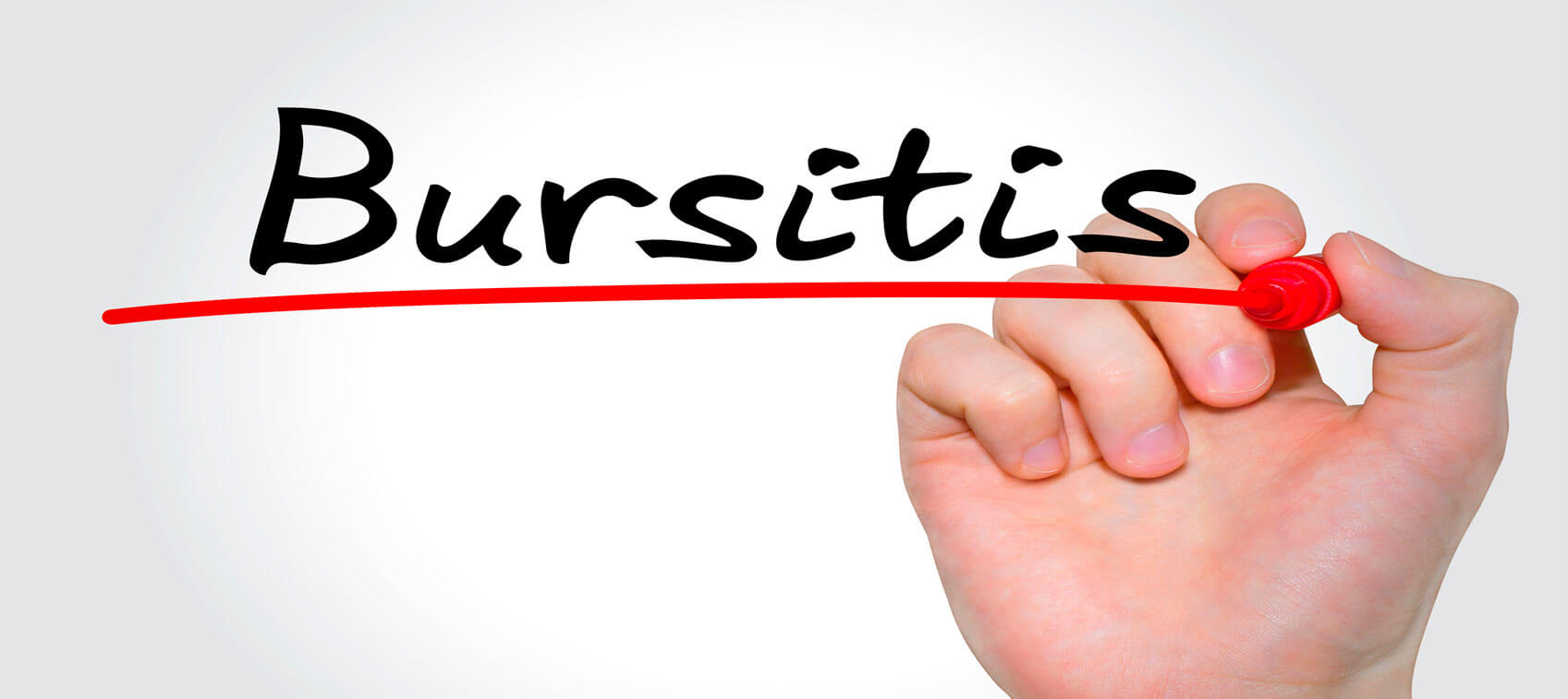
Bursitis means inflammation of the bursa. A bursa is a sac-like structure that contains a lubricating fluid. A bursa is located anywhere you need a lubricating cushion—like where a muscle or tendon rubs over a bone or another muscle.
Normally a bursa does its job unnoticed, but if you engage in some strenuous activity, for example, it can let you know exactly where it is. When a bursa is repeatedly irritated, the body begins to deposit calcium spicules in that location (often these deposits can be seen on X-rays). The spicules are like ground glass in the bursa, and the more you move that part of your body, the more intense the pain.
Types of Bursitis
Even though hundreds of bursa exist throughout your body, there are some typical problem areas. Here are the five common types of bursitis and the symptoms associated with each.
- Sub-deltoid bursitis. One of the unfortunate byproducts of dusting every piece of furniture in the house, washing and waxing your car, cleaning windows, working long hours in the garden, etc., is an inflamed shoulder bursa. When you have sub-deltoid bursitis, sleeping on your side can be difficult and just moving your arm can be extremely painful.
- Trochanteric bursitis. Another common and painful type of bursitis involves the bursa over the hip bone. If you move your hand along the side of your leg, you can feel a bony knob that sticks out from the hip bone (the trochanter of the femur bone). The muscles and skin that pass over this knob are lubricated by this bursa. Among other things, a long walk or exercise class after a sedentary winter can inflame this bursa. Trochanteric bursitis often makes walking difficult and painful and sleeping on your side impossible. It's also worth noting that the pain from this area is sometimes confused with sciatic nerve pain.
- Olecrenon bursitis. Your elbow can be another site for bursitis problems. Though not as common as sub-deltoid and trochanteric bursitis, it can leave you looking like you have a golf ball under the skin.
- Pre-patellar bursitis. Your knee is loaded with bursa. This type of bursitis is often referred to as "housemaid's knee," since constant kneeling from scrubbing floors can cause it. Although most people mop their floors nowadays, making true “housemaid’s knee” pretty obsolete, pre-patellar bursitis is still common among carpet layers and gardeners who typically spend long hours on their knees.
- Calcaneal bursitis. High heel shoes can claim credit for many cases of this type of bursitis, which affects the bursa in the heels. Shoes that are too tight or too large can also cause excessive pressure or rubbing on this bursa.
Home Remedies for Bursitis
No matter which type of bursitis you have, there are natural therapies to treat the pain and help you get back to your normal activities.
Rest
As soon as a bursa becomes inflamed, you must rest that part of your body. Don't try to "work it out," because any movement will only cause further irritation.
If it happens to be the bursa in your shoulder, for example, use an arm sling to help keep it completely still. If it's the bursa in your hip, stay off your feet. This may sound drastic, but you can usually relieve bursitis pain in two or three days simply by keeping the sore spot still.
Ice Only (For First-Time Bursitis Pain)
If this is the first time you’ve had bursitis, apply ice packs intermittently for the first 24 to 48 hours—usually 15 minutes on the bursa followed by 15 minutes off, for about an hour twice a day.
Ice and Moist Heat (For Recurring or Persistent Bursitis Pain)
If your bursitis flare-up is just one more episode in a chronic problem, or if your pain is new but still bothering you after 48 hours of applying ice, you should alternate ice packs and moist heat. Use 15 minutes of ice followed by 15 minutes of moist heat for about an hour twice a day. Moist heat penetrates deeper than dry heat and very often provides more relief from chronic bursitis pain.
One economical way to get moist heat at home is with a disposable baby diaper. By moistening the pad of a disposable diaper and then heating it in the microwave, you’ll have a reusable heating pad that will seal in the moisture. It’s also handy in that it can easily be wrapped and secured around joints. Obviously, you need to be careful when heating the diaper. To keep from overheating it, you’ll probably need to experiment a little to find the proper time and power setting on your microwave. Start with minimal time at minimal power, and work up from there.
Acid-Forming Foods to Remove Calcium Deposits
If you've had bursitis pain for months or years, you most likely have calcium deposits. This calcium can be slowly, but naturally, removed by altering your body's pH level to become more acidic. One tablespoon of apple cider vinegar in a glass of water daily, or an acid-calcium product, are two things you can use to do this. You can also temporarily increase your consumption of acid-forming foods.
Because of the confusion it generates, there is one point related to this recommendation that needs some clarification. Many people mistakenly think that taking calcium supplements can cause the formation of calcium deposits. This is not the case here. In fact, an insufficient amount of calcium can cause deposits. When your blood levels of calcium drop, your body pulls calcium from the bones, and this calcium often gets deposited in the overworked joints or bursa in an attempt to protect and strengthen these areas.
DMSO
Another home remedy for bursitis is dimethylsulfoxide (DMSO)—a clear, colorless, slightly oily liquid with a faint smell of sulfur. When applied topically, DMSO passes through the skin’s oily membranes and reduces swelling, inflammation, and pain.
DMSO is sold in both liquid and gel form. Use only the 99.9 percent liquid, as the creams and gels have been known to cause prolonged itching and irritation. Some people may still have a mild reaction to the liquid (usually warmth and a little itching at the site of application) when they first use DMSO, but it is temporary and no cause for concern.
To use DMSO, mix a solution of one part water and two parts DMSO (usually one capful of water and two capfuls of DMSO) and store it in a glass container. Using your fingers or a cotton swab, rub the DMSO directly into your skin. Most people suggest dabbing DMSO onto an area, but rubbing it on has been shown to improve the absorption time by up to 50 percent. A typical application is one to three teaspoons. Apply the DMSO at least three times a day.
Castor Oil Pack
While most of us are familiar with its use as a remedy for constipation, folk healers in this country and around the world have used castor oil to treat a number of health problems, including bursitis. One of the most economical and efficient methods of delivering the healing components of castor oil directly into body tissues is a castor oil pack.
To make a pack you will need:
- Cold pressed castor oil (about one-half cup)
- Standard heating pad
- Plastic garbage bag
- Two or three one-foot square pieces of wool or cotton flannel
- One large bath towel
Place the heating pad on a flat surface, turn the setting to high, and lay the plastic garbage bag on top of the pad. Next, soak the flannel pieces with castor oil and lay them on top of the bag and pad. Then place the entire pack against your skin, with the oil-soaked flannel directly on the area where you feel pain. To help hold the pack in place and to keep oil from getting on surrounding surfaces, the body can be wrapped in a large bath towel.
The pack should remain in place for at least one hour and the temperature of the heating pad should be kept at the highest temperature tolerable. When you remove the pack, the remaining oil can be massaged into the skin or cleaned off using a little soda water made from 1 quart of warm water and 2 tablespoons of baking soda. The flannel can be reused if stored in either a zippered freezer bag or plastic container and placed in the refrigerator. Before the next use, let it warm up and add another one or two tablespoons of oil. (After a month of use, I would recommend using new flannel.)


